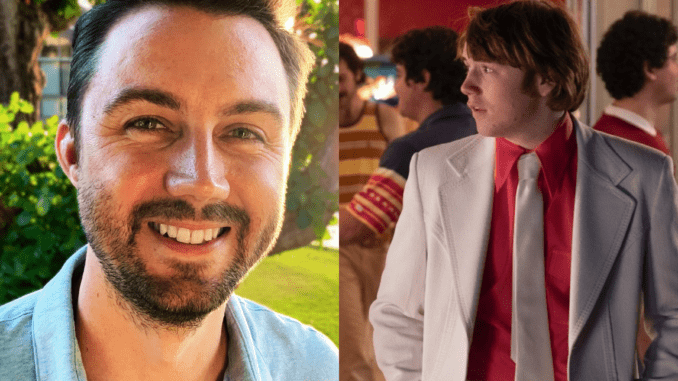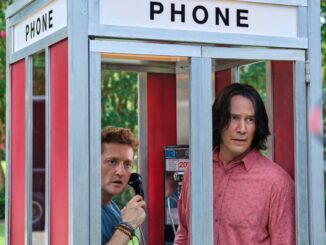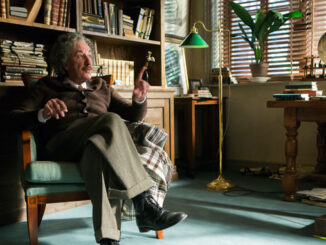
By Rob Feld
While studying film at UC Santa Barbara, Andy Jurgensen quickly found editing to be the perfect blend of storytelling, puzzle-piecing, and technical expertise. His first job out of school was at Sidney Kimmel Entertainment, where he learned the inner workings of the industry and wrangled his first production job as a post coordinator on the feature “Charlie Bartlett.”
Moving on to assist editors – such as Alan Baumgarten, ACE; Leslie Jones, ACE; and Dylan Tichenor, ACE, among others — he learned the lesson that a core function of an editor’s job is to keep the train moving amidst a flurry of opinions and challenges, good days or bad.
Jurgensen began to be drawn into the director Paul Thomas Anderson’s inner circle when Leslie Jones got the call to cut “Inherent Vice,” and Jurgensen was asked to assist. Since Anderson shoots on film, conforms workprint, and finishes photochemically, the project offered a unique challenge to Jurgensen as he learned skills core to Anderson’s processes. As happens in Anderson’s world, Jurgensen was subsequently drawn into smaller projects, cutting music videos for the band Haim and Thom Yorke, his short documentary “Junun,” and continuing to assist Tichenor on “Phantom Thread,” further establishing a rapport and trust until Anderson asked Jurgensen to edit “Licorice Pizza.”
The film tells the story of Alana Kane (Alana Haim) and Gary Valentine (Cooper Hoffman) coming of age in the San Fernando Valley circa 1973. Gary is a precocious child actor, who sets his sights on the older Alana when she comes to his high school to as a photographer’s aid on picture day. As Alana struggles with her future, she finds Gary intriguing and, in fits and starts, allows him to pull her into his world, side-hustles, and adventures. The unconventional love story is full of episodic surprises, deeply rooted in characters developed with a careful eye. Jurgensen claims it came together easily due to Anderson’s strongly constructed script but the film shows a clear collaborator’s understanding, born of trust and time. (Mild spoilers follow.)
CineMontage: You really didn’t leave a spot of extra air in this movie. Every scene comes in late and gets out early. Was this part of a conversation with Anderson?
Andy Jurgensen: Yes, that was something we discussed early on. It’s a very youthful movie and a lot happens so we talked about keeping the momentum going from scene to scene. It doesn’t hurt that we also have a lot of running.
CineMontage: Was it scripted so tightly that it lent itself to that approach? Was there a scene that was a particular struggle?
Jurgensen: The film pretty much sticks to the script, but there were some scenes that had to be reshaped. The section that we struggled with the most was the Tail O’ the Cock sequence with Sean Penn and Tom Waits. You have a lot of different perspectives to cover: Jack and Alana having their little conversation at the table, then Rex joining, and later Gary and his friends coming in and witnessing the action from across the restaurant. The first cut of that was a lot longer and got bogged down with too many details. We had to whittle it down to its essence – which is just a crazy, drunken whirlwind.
CineMontage: With so much to track in that scene, what was your true north?
Jurgensen: The evolving relationship between Gary and Alana is at the core. I think this is a hard film to put in a box. It’s a romance of sorts, but it’s also a comedy; it’s “coming of age,” it’s “slice of life.” It’s about the journey. Throughout the movie we’re bringing Alana and Gary together, then breaking them apart, bringing them together, and then breaking them apart. That’s the ride of it.
CineMontage: Did the footage conscribe your cuts or was there a good deal to find in editorial?
Jurgensen: Some of both. In the scene when Gary first meets Jon Peters, there was a lot of improv to sift through. For other scenes, like the musical sequences, you can tell how it’s going to flow based on camera movements and blocking. The movie’s filled with needle drops and we’re using songs to heighten the emotion. A moment I’m thinking of, one of the iconic scenes of the film, is when they’re lying on the waterbed with “Let Me Roll It” playing. Paul had a plan forhow the choreography and timing was going to play out with Gary looking over and then hovering his hand over Alana’s chest at a specific lyric in the song.
CineMontage: What has your collaborative process come to look like with Anderson?
Jurgensen: One thing that Paul does that not a lot of other directors do is that we make time to watch dailies togetherduring the shoot. We watch them big on film with other key crew members so we’re able to analyze technical elementslike lighting and focus, but also see performances in detail. Often, Paul will play music that he’s thinking of using for a scene. You can get a real sense of whether a performance is working in this communal setting. Things can evolve after watching dailies and sometimes we’ll reshoot if we feel like we didn’t get it. I take detailed notes of our favorite takes and that informs how we build the first assembly.
CineMontage: If Anderson knows he’s using a song in a scene from the radio, is he recording that live on set or is that all post?
Jurgensen: We did some live recording. The on-set mixer recorded a handful of songs through the PA system in the pinball palace, which helped dirty it up, especially mixed with all the pinball sounds. And in post, the sound supervisors recorded many of the radio cues through old car speakers. It feels more natural and you don’t have to do too much processing in Pro Tools. Even the telephone calls were done practically. In the prank call scene, the off-screen actor was on a phone in the other room and we put a mic in the earpiece in order to capture that real phone futz quality. So all the off camera breathing was natural and recorded on set. The movie is about nostalgia and recreating a time and place, so that goes for the sounds, the music, the photography, the setting, and the characters. Hopefully the audience feels thisauthenticity and is seeing part of their adolescence in this young love story.
CineMontage: It is a constantly surprising story. You talked about how it unfolds to these vignettes. How did you balance them?
Jurgensen: Since the movie does have these chapters or episodes, it was about making sure that one didn’t outweigh the others. That’s why we had to tighten the Tail O’ The Cock sequence. It can be a balancing act to move the story along by providing just enough information. Paul doesn’t want the audience to get ahead of his films. He’s always talked about that, even in previous movies: “The audience is smart enough. Maybe they’ll be a little confused, but they’ll catch up and it’s fine.”
CineMontage: Alana’s and Gary’s stories felt equally serviced to me.
Jurgensen: We did try to balance it out, although in the end we realized it’s more of Alana’s story rather than Gary’s. I mean, she’s the one who really changes. From the beginning, Gary is a showman. He’s confident and an entrepreneur. But Alana lacks direction and feels stuck between adolescence and adulthood. Her adventure with Gary opens up a new side to her life – new friends, new experiences. When you get to the section with Joel Wachs, you can see she’s evolving. She’s becoming more mature and trying to have her own identity. It’s definitely a back and forth, but Alana is the one that has the bigger character arc.
CineMontage: So as you came to discover that, what shots were you choosing to bring her forward?
Jurgensen: There’s that pivotal restaurant scene in the end at Rive Gauche, between Joel, Joel’s boyfriend, and Alana. We’re holding on Alana’s reflection in the mirror for a long time as she’s processing what she’s hearing. I interpret this asthe moment where she fully grows up. She has this epiphany that she needs to find Gary. Do I think that they’re going to get married and be together for the rest of their lives? Absolutely not. The next day, they’re probably fighting and not talking to each other. That’s just the kind of relationship they have. The point is that she found someone who understands and appreciates her.
CineMontage: Do you cut with Anderson or does he give you a chance to work and bring him rough cuts?
Jurgensen: Well, I don’t show him a big first assembly. I take notes during our dailies screenings and keep adding them to a huge binder. During production, I have my own process of watching stuff again in the Avid and marking things and pulling selects. Often, I’ll do a rough-cut of a scene and string sequences together… but Paul likes crafting the first cutwith me. We just start at the beginning and go through it. Because we do a lot of the leg work during dailies, things fall into place rather quickly. We wrapped in the middle of November and we had a full two hour and 45 minute version by New Year’s. Then we started whittling things down. He definitely wants me to experiment and try things on my own though. It’s very collaborative.
CineMontage: The movie is screening in 70mm. What was your technical process?
Jurgensen: The movie was shot on 35mm film. We cut workprint, then negative, and struck 35mm prints that are photochemically timed by Fotokem. I’d say that’s Paul’s ultimate version of the movie. To make the 70mm, you have to create a special interpositive print of the 35mm negative to make a new larger format negative. What we ended up doing for the DCP, and later, for home video is scan this interpositive print. It softens the image and adds some glow. When you’re watching film, you get that flicker effect, so it adds some of that too. There are a few sections that we did use the negative scans if the flicker was too strong.
What you get in the end is a very specific texture in the transfer that replicates the look of a ‘70s movie. No digital tricks!






